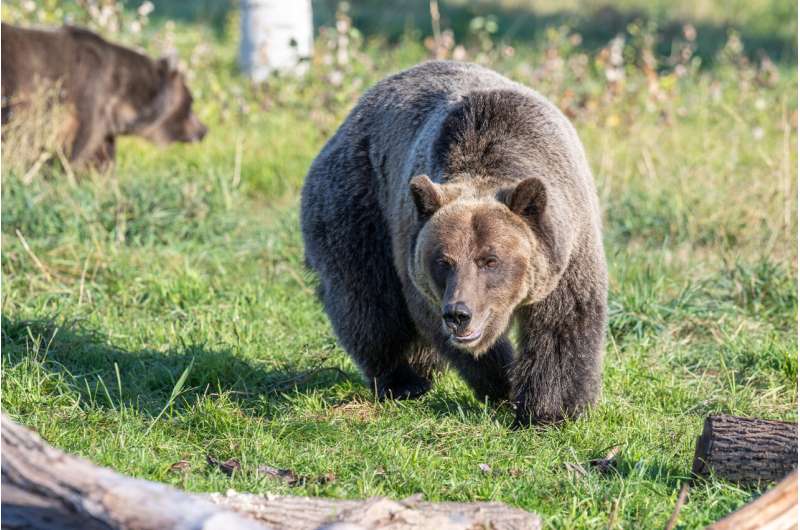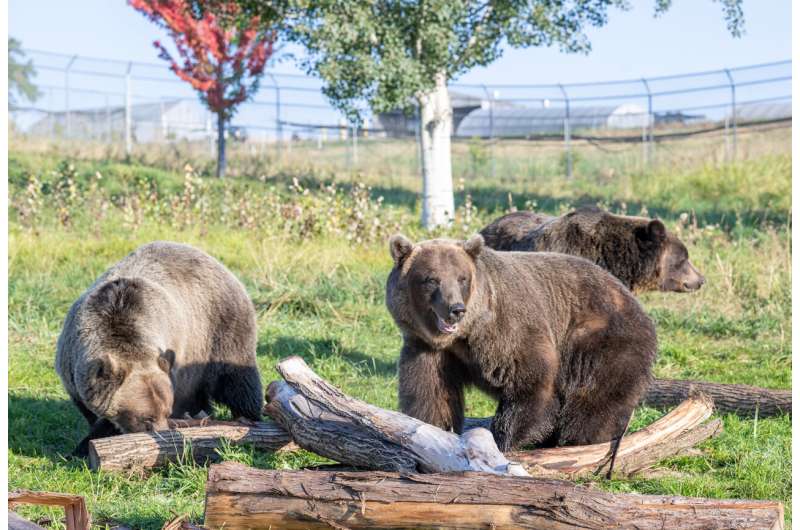This article has been reviewed according to Science X's editorial process and policies. Editors have highlighted the following attributes while ensuring the content's credibility:
fact-checked
peer-reviewed publication
trusted source
proofread
Bear genes show circadian rhythms even during hibernation

The internal clocks of grizzly bears appear to keep ticking through hibernation, according to a genetic study. This persistence highlights the strong role of circadian rhythms in the metabolism of many organisms including humans.
The Washington State University-led genetic study confirmed observational evidence that bears' energy production still waxes and wanes in a daily pattern even as they slumber for several months without eating. The researchers also found that during hibernation the amplitude of the energy production was blunted, meaning the range of highs and lows was reduced. The peak also occurred later in the day under hibernation than during the active season, but the daily fluctuation was still there.
"This underscores the importance of the circadian rhythms themselves—that they give organisms the flexibility to still function in a state as extreme as a hibernating bear," said Heiko Jansen, a professor in WSU's integrative physiology and neuroscience department and senior author on the study in the Journal of Comparative Physiology B.
Other research has shown that circadian rhythms, the 24-hour physical cycles common to most living animals on Earth, have ties to metabolic health. In humans, major disruptions to these patterns, such as occur in night shift work, have been linked to metabolic problems like weight gain and higher prevalence of diabetes.
In some sense, bears are extreme shift workers, taking as much as six months off when they hibernate. Researchers like Jansen's team are attempting to figure out how they engage in seemingly unhealthy habits of gaining excessive weight then going without food and not moving much for several months—all without detrimental effects like loss of bone mass or diseases like diabetes.
Unlike hibernating rodents who are almost comatose, bears do move around occasionally during this dormant period. Through observation studies of grizzly bears at the WSU Bear Center, researchers found these movements tend to follow a circadian rhythm with more activity during the day than at night.
In the current study, the researchers looked to see if that circadian rhythm was expressed on the cellular level. They took cell samples from six bears during active and hibernating seasons, then cultured those cells to conduct an array of genetic analyses.
To mimic hibernation, the researchers examined the cells at the bears' typical lowered body temperature during hibernation at about 34 degrees Celsius (93.2 degrees Fahrenheit) and compared that to 37 C (98.6 F) during the active season.

They found thousands of genes were expressed rhythmically in hibernating bear cells. This translated into rhythms of energy through rise and fall of production of adenosine triphosphate or ATP, the body's cellular source of energy. ATP was still produced in a daily pattern under hibernation but the production had a blunted amplitude, lower peaks and valleys. The highest production point also shifted to later in the day under hibernation than under active season conditions.
Maintaining a circadian rhythm requires some energy itself. The researchers believe that by altering this rhythm some during hibernation may allow bears to still get some energetic benefit of the daily cycle without as much of cost—which likely helps them survive going without food for months.
"It's like setting a thermostat. If you want to conserve some energy, you turn down the thermostat, and this is essentially what the bears are doing," Jansen said. "They're using the ability to suppress the circadian rhythm, but they don't stop the clock from running. It's a really novel way of fine-tuning a metabolic process and energy expenditure in an animal."
Co-authors on the study include first author Ellery Vincent as well as Blair Perry and Charles Robbins of WSU and Joanna Kelley of University of California, Santa Cruz.
More information: Ellery P. Vincent et al, Circadian gene transcription plays a role in cellular metabolism in hibernating brown bears, Ursus arctos, Journal of Comparative Physiology B (2023). DOI: 10.1007/s00360-023-01513-5
Journal information: Journal of Comparative Physiology B
Provided by Washington State University



















